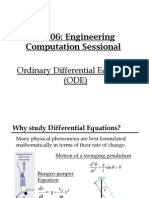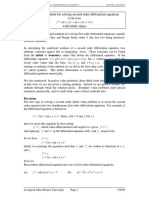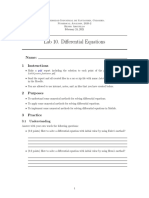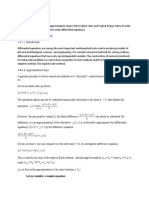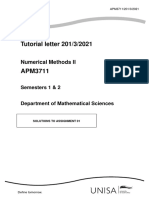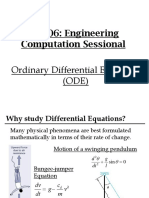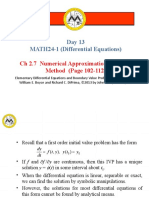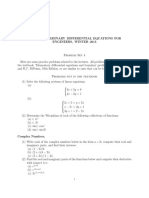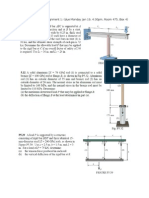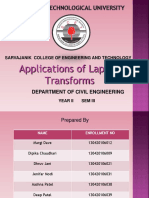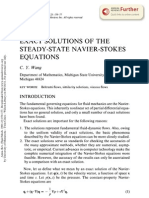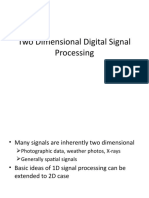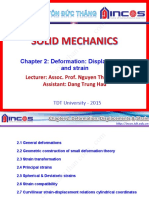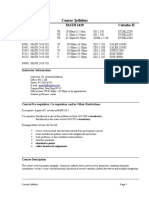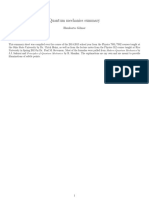MATH 263: ORDINARY DIFFERENTIAL EQUATIONS FOR
ENGINEERS, SUMMER 2015
Problem Set 3
Here are some practice problems related to the lectures. Most of the problems are either
from from the textbook “Elementary differential equations and boundary problems”, by
W.B. Boyce and R.C. DiPrima, 10th Edition, or are similar to ones that can be found there.
Problems from Section 2.2
Solve the following equations.
dy x2 +xy+y 2
2.2.31 dx
= x2
.
dy x+3y
2.2.35 dx
= x−y
.
Problems from Section 2.4
Bernouilli Equations. An equation of the form
y 0 + p(t)y = q(t)y n ,
is called a Bernoulli equation.
2.4.27.(a) Solve Bernoulli’s equation when n = 0; when n = 1.
2.4.27.(b) Show that if n 6= 0, 1, then the substitution v = y 1−n reduces Bernoulli’s equation
to a linear equation.
2.4.28 Solve the equation t2 y 0 + 2ty − y 3 = 0 for t > 0.
Problems from Section 2.6
Determine whether each of the equations below are exact. If it is exact, find the general
solution.
2.6.1 (2x + 3) + (2y − 2)y 0 = 0.
2.6.2 (2x + 4y) + (2x − 2y)y 0 = 0.
dy
2.6.5 dx
= − ax+by
bx+cy
.
dy
2.6.6 dx
= − ax−by
bx−cy
.
1
�2 MATH 263: ORDINARY DIFFERENTIAL EQUATIONS FOR ENGINEERS, SUMMER 2015
2.6.9 (yexy cos(2x) − 2exy sin(2x) + 2x) + (xexy cos(2x) − 3)y 0 = 0.
2.6.10 (y/x + 6x) + (ln(x) − 2)y 0 = 0, where x > 0.
2.6.13 Solve the intial value problem (2x − y) + (2y − x)y 0 = 0, y(1) = 3 and determine at
least approximately where the solution is valid.
For each of the equations below find an integrating factor and solve the given equation.
2.6.26 y 0 = e2x + y − 1.
2.6.27 1 + (x/y − sin(y))y 0 = 0.
2.6.29 ex + (ex cot(y) + 2y csc(y))y 0 = 0.
Section 2.7
In each of the problems below use Euler’s method to find approximate values of the solution
of the given initial value problem at t = 0.5, 1, 1.5, 2, 2.5 and 3:
√
2.7.11 y 0 = 5 − 3 y, y(0) = 2.
2.7.14 y 0 = −ty + 0.1y 3 , y(0) = 1. Write MatLab code that solves these problems too.
Section 8.2
Use the improved Euler method with step size h = 0.05 and h = 0.0.25 to solve the initial
value problem
8.2.1 y 0 = 3 + t − y, y(0) = 1
8.2.3 y 0 = 2y − 3t, y(0) = 1.
Write MatLab code which solves this problems too.
Problems not in the book
Substitutions.
Solve the following equations.
(1) (x + 2y)y 0 = y.
(2) y0 = √(4x + y)2 .
(3) y 0 = x +p y + 1.
0
(4) yy + x = x2 + y 2 .
Numerical Methods.
(1) (See for instance 2.7.4.) Consider the initial value problem x0 = 3 cos t−2x, x(0) = 0.
� MATH 263: ORDINARY DIFFERENTIAL EQUATIONS FOR ENGINEERS, SUMMER 2015 3
(a) Use Euler’s method with step size h = 0.1 to find approximate values of the
solution at t = 0.1, 0.2, 0.3, and 0.4.
(b) Use Euler’s method with step size h = 0.05 to find approximate values of the
solution at t = 0.1, 0.2, 0.3, and 0.4.
(c) Find the exact solution of the initial value problem. Then determine the local
and global error of your previous calculations.
2 +2ty
(2) (See for instance 8.2.1.) Consider the initial value problem y 0 = y3+t 2 , y(0) = 0.5.
(a) Use the improved Euler’s method with step size h = 0.05 to find approximate
values of the solution at t = 0.1, 0.2, 0.3, and 0.4.
(b) Use the improved Euler’s method with step size h = 0.025 to find approximate
values of the solution at t = 0.1, 0.2, 0.3, and 0.4.
(c) Find the exact solution of the initial value problem. (The problems from Section
2.4 at the beginning of this problem set may be helpful.) Then determine the
local and global error of your previous calculations.
(3) Using Matlab, modify the programs posted on myCourses to use the improved Euler
method (instead of the (forward) Euler method) to solve the initial value problem
dx
= −2x, subject to x (0) = 10
dt
from t = 0 to T = 1, and produce the following plots:
(a) Local convergence (loglog of local error versus h)
(b) Global convergence (loglog of local error versus h)
(c) On the same graph plot the exact solution x (t) versus t, the computed solution
using the (forward) Euler method and the computed solution using the improved
Euler method for h = 1/10.












